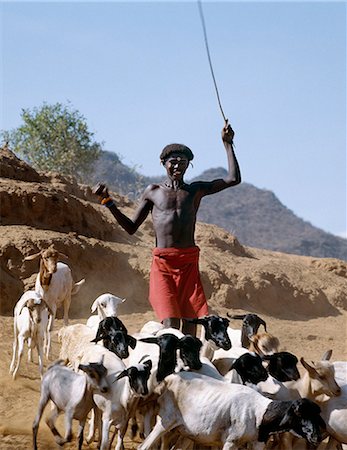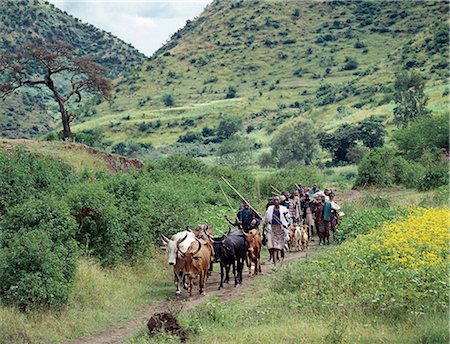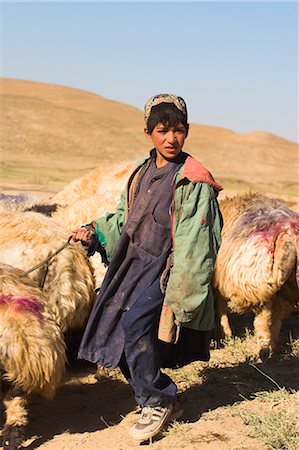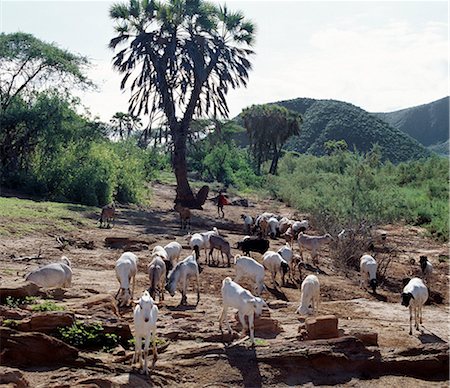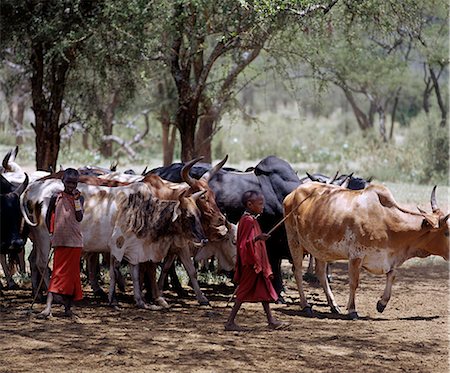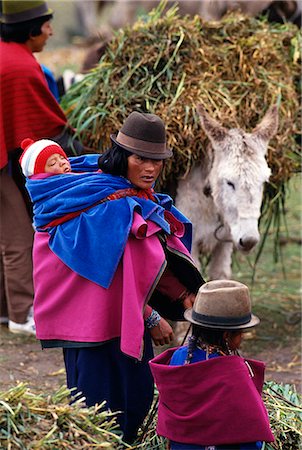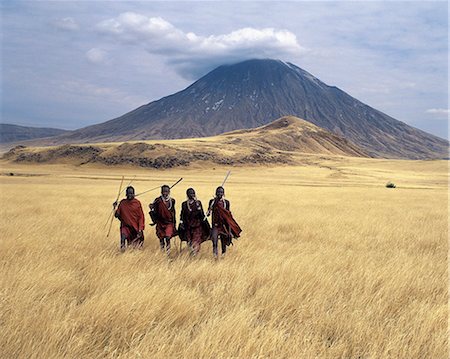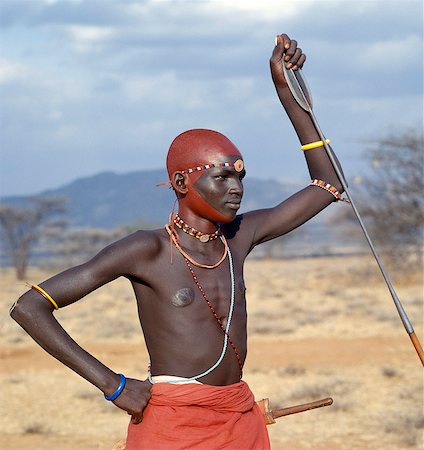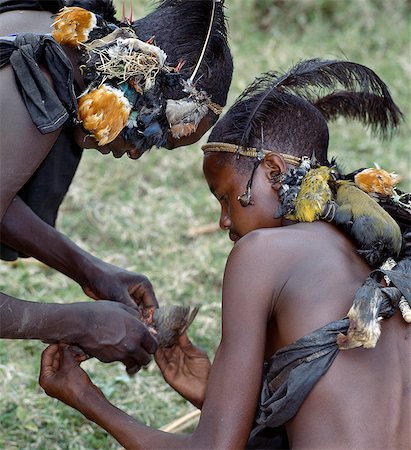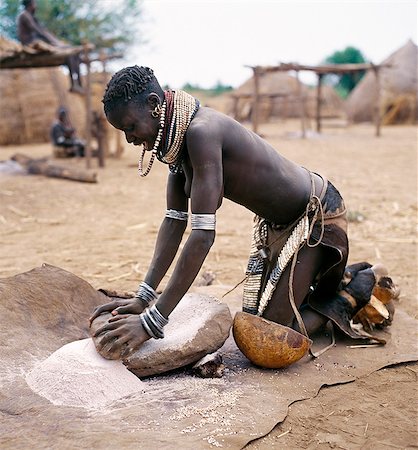-
A young Maasai herdsboy controls his family's cattle at the Sanjan River to prevent too many animals watering at the same time.
Rights-Managed
-
Two young Datoga men work wells on the east side of Lake Manyara to water their family's livestock. The man who draws water balances precariously on two poles.The Datoga (known to their Maasai neighbours as the Mang'ati and to the Iraqw as Babaraig) live in northern Tanzania and are primarily pastoralists.
Rights-Managed
-
Up to a year before his circumcision,a Samburu boy will style his hair is a distinctive 'pudding bowl' shape and often rub charcoal and fat into it.Uncircumcised boys are considered children whatever their age. They have no standing in the tribe and do not belong to an age-set..
Rights-Managed
-
A young Galla herdsboy with his family's cattle outside their homestead.
Rights-Managed
-
Turkana women and girls are responsible for watering livestock,which is unusual among pastoral societies. Here,a young girl waters goats from a waterhole dug in the sand of a seasonal watercourse. Her young brother will control the flow of stock to the water trough. In the background,a man digs out another waterhole; they have to been deepened regularly towards the end of the dry season.
Rights-Managed
-
Turkana women and girls are responsible for watering livestock,which is unusual among pastoral societies. Here,a girl waters cattle from a Waterhole dug in the sand of a seasonal watercourse. The Turkana manipulate the horns of their ox's into perfect symmetry or any whimsical shape that takes the owner's fancy.
Rights-Managed
-
A young Samburu herdsman drives goats towards a Waterhole along the Milgis - a wide,sandy seasonal watercourse which is a lifeline for pastoralists in the low-lying semi-arid region of their district. The hair style of the young man denotes his status as an uncircumcised youth.
Rights-Managed
-
A Maasai warrior and a young herdsboy draw water for livestock from the deep wells at Naberera where cattle paths are cut deep into the soil to allow livestock nearer to the source of water.
Rights-Managed
-
A young Maasai herdsboy drives his family's herds to grazing grounds close to the Sanjan River in Northern Tanzania.
Rights-Managed
-
A Maasai warrior drives his family's cattle to the Sanjan River in northern Tanzania
Rights-Managed
-
Two Maasai warriors,spears on their shoulders,leave the friable dusty banks of the Sanjan River after watering their cattle.
Rights-Managed
-
Deep Maasai wells at Loibor Serrit where cattle paths are cut deep into the soil to allow livestock nearer to the source of water. Despite this immense amount of manual labour.Four fit, young men are necessary to bring water to the stock troughs about 30 feet above the water level at the bottom of the hand dug wells.
Rights-Managed
-
A Pokot warrior with a traditional blue clay hairstyle tends his camels in a lugga (seasonal watercourse) while waiting his turn to water them from a deep well.
Rights-Managed
-
A Maasai boy herds his family's cattle near a waterhole in the foothills of Ol doinyo Orok (the Black Mountain). Childhood is very short in Maasailand; children begin to help their parents at a young age and may never attend school.
Rights-Managed
-
In the early morning,young Samburu girls take kids to their mothers. They will then milk the nanny goats leaving half the milk for the kids. Only women and children milk goats although every member of the family will drink the milk.
Rights-Managed
-
In the early morning,a young Samburu girl takes a kid to its mother. She will then milk the nanny goat leaving half the milk for the kid. Only women and children milk goats although every member of the family will drink the milk.
Rights-Managed
-
A Samburu woman milks a camel at her homestead in the early morning. The proximity of the calf helps to stimulate the flow of milk. Baby camels have a wool-like texture to their coats,which they lose after six month.
Rights-Managed
-
A Samburu girl drives her family's flocks of fat-tailed sheep and goats to grazing grounds after her brothers have watered them from wells dug in the Milgis - a wide,sandy seasonal watercourse that is a lifeline for Samburu pastoralists in the low-lying,semi-arid region of their land.
Rights-Managed
-
A Samburu Warrior drives his goats along the wide,sandy seasonal watercourse of the Milgis where waterholes dug by the Samburu in the dry season are a lifeline for pastoralists in this semi-arid region of their district.
Rights-Managed
-
Maasai pastoralists water their livestock at the seasonal Sanjan River,which rises in the Gol Mountains of northern Tanzania.
Rights-Managed
-
Maasai men,spears in hand,drive their laden donkeys across pristine volcanic grassland at the southern end of Lake Natron. Donkeys carry loads in leather panniers strapped loosely to their flanks
Rights-Managed
-
Maasai livestock watering at the seasonal Sanjan River,which rises in the Gol Mountains of northern Tanzania.
Rights-Managed
-
Maasai livestock watering at the seasonal Sanjan River,which rises in the Gol Mountains of northern Tanzania.
Rights-Managed
-
In the early morning,a Maasai family drives their livestock across the friable,dusty plains near Malambo in northern Tanzania.
Rights-Managed
-
In the early morning,a Maasai herdsboy and his sister drive their family's flock of sheep across the friable,dusty plains near Malambo in northern Tanzania.
Rights-Managed
-
A Dassanech woman milks a cow by hand collecting the milk in a gourd at a settlement alongside the Omo River. Much the largest of the tribes in the Omo Valley numbering around 50,000,the Dassanech (also known as the Galeb,Changila or Merille) are Nilotic pastoralists and agriculturalists.
Rights-Managed
-
A Dassanech youth sits on his wooden stool on a bank of the Omo River.Every man has his own stool, which doubles as a pillow at night.The Omo Delta of southwest Ethiopia is one of the least accessible and least developed parts of East Africa.As such, the culture, social organization, customs and values of the people have changed less than elsewhere.
Rights-Managed
-
Farmers drive livestock to Senbete market, which is an important weekly market close to the western scarp of the Abyssinian Rift.Agriculture forms the background of the countrys economy with 90 percent of its population earning a living from the land.
Rights-Managed
-
A Dassanech man stands on one leg in typical pose while looking after his familys cattle in the Omo Delta, one of the largest inland deltas in the world. The extensive scarification on his chest and shoulders denotes that he has killed an enemy.They practice animal husbandry and fishing as well as agriculture.
Rights-Managed
-
A Dassanech man stands on one leg in typical pose while looking after his familys cattle in the Omo Delta, one of the largest inland deltas in the world. The extensive scarification on his chest and shoulders denotes that he has killed an enemy.They practice animal husbandry and fishing as well as agriculture.
Rights-Managed
-
A Maasai elder herds his cattle near the foothills of Ol doinyo Orok (the Black Mountain).
Rights-Managed
-
A Maasai warrior resplendent with his long ochred braids tied in a pigtail watches over his family's cattle,spear in hand. The singular hairstyle of warriors sets them apart from other members of their society.
Rights-Managed
-
Maasai herdsmen drive their cattle home in the late afternoon over the dusty volcanic soil at the base of the western wall of the Gregory Rift,which dominates the landscape in this remote corner of northern Tanzania.
Rights-Managed
-
Datoga herdsmen drive their family's cattle along the edge of Lake Balangida Lelu,a seasonal alkaline lake situated due south of Lake Eyasi in northern Tanzania. Balang'ida in the Datoga language means 'salt'.The Datoga (known to their Maasai neighbours as the Mang'ati and to the Iraqw as Babaraig) live in northern Tanzania and are primarily pastoralists.
Rights-Managed
-
In the late afternoon, a group of Dassanech children walk in single file beneath a large wild fig tree along a bank of the Omo River in Southwest Ethiopia.The Dassanech speak a language of Eastern Cushitic origin.They live in the Omo Delta and they practice animal husbandry and fishing as well as agriculture.
Rights-Managed
-
In the late afternoon, a group of Dassanech children wave to passing visitors along a bank of the Omo River in Southwest Ethiopia.The Dassanech speak a language of Eastern Cushitic origin.They live in the Omo Delta and they practice animal husbandry and fishing as well as agriculture.
Rights-Managed
-
Shepherd boy tending his flock, between Chakhcharan and Jam, Afghanistan, Asia
Rights-Managed
-
Camels are milked in the early morning by Turkana herdsmen. In the best season of year,camels can be milked up to five times a day making them the most important livestock resource the Turkana own. However,these animals do not have the same cultural and emotional value to the Turkana as cattle.
Rights-Managed
-
Dressed in his black goatskin cloak,a Samburu boy puts his bundle of sticks,staves and gum on the roof of his mother's house. He has collected these with other boys from a special type of Commiphora tree during an arduous journey on foot of up to 200 miles. After his circumcision,he will make them into bows,blunt arrows and clubs.
Rights-Managed
-
A Samburu boy herds his family's goats in the semi-arid terrain of northern Samburuland,a region characterised by grand vistas,poor soil and an unreliable rainfall. The palms are doum palms (Hyphaene compressa),which grow widely in Kenya.
Rights-Managed
-
Two young Maasai girls help to herd their family's cattle near a waterhole in the foothills of Ol doinyo Orok (the Black Mountain). Childhood is very short in Maasailand; children begin to help their parents at a young age and may never attend school.
Rights-Managed
-
A proud Turkana father and his young daughter. Both their hairstyles are typical of tribal custom in the west of Turkanaland.
Rights-Managed
-
In the late afternoon,a Maasai boy drives his father's cattle home across the grassy plains west of the Lake Manyara National Park.
Rights-Managed
-
In the late afternoon,a Maasai boy drives his father's cattle home across the grassy plains west of the Lake Manyara National Park.
Rights-Managed
-
Maasai men,spears in hand,drive their laden donkeys across pristine volcanic grassland at the southern end of Lake Natron. Donkeys carry loads in leather panniers strapped loosely to their flanks.
Rights-Managed
-
A young boy of the Datoga tribe crosses the plains east of Lake Manyara in Northern Tanzania. The Manyara escarpment (a western boundary wall of the Gregory Rift) is visible in the distance. The Datoga (known to their Maasai neighbours as the Mang'ati and to the Iraqw as Babaraig) live in northern Tanzania and are primarily pastoralists..
Rights-Managed
-
Berber goat herder on plains at foot of Erg Chegaga,Sahara,Southern Morocco.
Rights-Managed
-
Local woman carrying baby in a wrap in a traditional market,Zalaron,Chimborazo Province,Ecuador
Rights-Managed
-
Local woman with her dog in a traditional market,Zalaron,Chimborazo Province,Ecuador
Rights-Managed
-
An Aymara woman winnows quinoa,the staple grain of the Andes,at the village of Tahua on the northern shore of the Salar de Uyuni,the world's largest salt flat.
Rights-Managed
-
Australia, Queensland, Laura. Lockhart River dancers at the Laura Aboriginal Dance Festival.
Rights-Managed
-
Turkana girls return home from a Waterhole with water containers made of wood. Their cloaks are goatskin embellished with glass beads.
Rights-Managed
-
Karo men paint each other in preparation for a dance in the village of Duss. A small Omotic tribe related to the Hamar,who live along the banks of the Omo River in southwestern Ethiopia,the Karo are renowned for their elaborate body painting using white chalk,crushed rock and other natural pigments.
Rights-Managed
-
A smart young Hamar youth at Turmi Market.The Hamar are semi-nomadic pastoralists who live in harsh country around the Hamar Mountains of Southwest Ethiopia. Their whole way of life is based on the needs of their livestock. Cattle are economically and culturally their most important asset.
Rights-Managed
-
Long horned Ankole cattle are prized among the people of southwest Uganda and Rwanda.The Bayarwanda speaking people living close to the Rwanda border use an unusual bell-shaped wooden pot, called ekyanzi, for storing fresh milk.
Rights-Managed
-
A Datoga young man in traditional attire.His braids are embellished with beads and aluminium can openers.Many of his white plastic bracelets are beautifully decorated with abstract and geometrical designs; long ago these bracelets would have been made of ivory.
Rights-Managed
-
Maasai warriors stride across the golden grass plains at the foot of Ol doinyo Lengai, the Maasais Mountain of God. Ol doinyo Lengai is the only active volcano in the Gregory Rift, an important section of the eastern branch of Africas Great Rift Valley system that stretches from northern Kenya into Northern Tanzania.
Rights-Managed
-
Kenya, Samburu District, Wamba.Immediately an initiate completes his lmuget loolbaa ceremony a month after his circumcision, he becomes a junior warrior of the Samburu tribe. From wearing a drab black cloak and carrying a bow and arrows, he proudly dons the ochred finery of a warrior, spear in hand. Overnight, he is transformed from a boy into a man, confident of his new role in tribal affairs.
Rights-Managed
-
Samburu initiates sing during the month after their circumcision. As their wounds heal, their dances become more energetic. Before long, they imitate the dances of the warriors which, hitherto, they have been forbidden to perform.They spend much of their time wandering in the countryside attempting to kill as many birds as they can with a club and four blunt arrows. When a bird is killed, it is sk
Rights-Managed
-
Samburu initiates skin a bird without the use of a knife.While their wounds heal for a month after circumcision, initiates spend their time wandering in the countryside attempting to kill as many birds as they can with a club and four blunt arrows. When a bird is killed, it is skinned, stuffed with dry grass and attached to the boy's headband by means of its beak.
Rights-Managed
-
A Samburu initiate takes aim at a bird with a blunt arrow.While their wounds heal for a month after circumcision, initiates spend their time wandering in the countryside attempting to kill as many birds as they can with a club and four blunt arrows. When a bird is killed, it is skinned without a knife, stuffed with dry grass and attached to the boys headband by means of its beak.
Rights-Managed
-
Kenya, South Horr, Kurungu.A Samburu youth after his circumcision. The day after he has been circumcised, the initiate must hang in his pierced earlobes copper ear ornaments that are normally worn by married women. His sponsors make him a new headdress of ostrich feathers fastened to a narrow band of plaited fibre, which fits tightly round his forehead like a sweatband.
Rights-Managed
-
A Samburu mother shaves her sons head outside her home the day before he is circumcised.Round her neck hangs his nchipi, the distinctive decoration of every boy who participates in the circumcision ritual. The strings of blue beads terminate in large bronze coloured wings of a torpedo shaped beetle, Sterocera hildebrandti.
Rights-Managed
-
A Samburu boy the day before his circumcision.He has daubed the right side of his face and body with white clay while drawing water from a source that never dries up. Each boy will carry for this purpose a new gourd shaped container made by his mother from hollowed out wood.
Rights-Managed
-
Mothers rub animal fat into their sons cloaks to make them supple. This task is performed shortly before the boys set out on an arduous journey to collect sticks, staves and gum to make bows, blunt arrows and clubs after their circumcision.
Rights-Managed
-
A Samburu boy in reflective mood after his circumcision.A day after the ordeal, he will hang in his pierced earlobes copper earrings normally worn by married women and put on a new headdress of ostrich feathers fastened to a narrow band of plaited fibre, which fits tightly round his forehead.
Rights-Managed
-
A Nyangatom woman grinds sorghum using a flat stone.The Nyangatom are one of the largest tribes and arguably the most warlike people living along the Omo River in Southwest Ethiopia.They form a part of the Ateger speaking people a cluster of seven eastern Nilotic tribes to which the Turkana of Northern Kenya and the Karamajong of Eastern Uganda belong.
Rights-Managed
-
In the late afternoon, Nyangatom villagers enjoy singing and dancing. As groups of men take centre stage to jump high in the air, women and girls sing, clap to a rhythm, and move slowly towards the men. Children enjoy the excitement in the background.The Nyangatom are one of the largest tribes and arguably the most warlike people living along the Omo River in Southwest Ethiopia.
Rights-Managed
-
In the late afternoon, Nyangatom villagers enjoy singing and dancing. As groups of men take centre stage to jump high in the air, women and girls sing, clap to a rhythm, and move slowly towards the men. Children enjoy the excitement in the background.The Nyangatom are one of the largest tribes and arguably the most warlike people living along the Omo River in Southwest Ethiopia.
Rights-Managed
-
A very tall, armed Nyangatom herdsman drives cattle through arid, dusty country to water on the Omo River.The Nyangatom are one of the largest tribes and arguably the most warlike people living along the Omo River in Southwest Ethiopia.
Rights-Managed
-
A very tall, armed Nyangatom herdsman drives cattle through arid, dusty country to water on the Omo River.The Nyangatom are one of the largest tribes and arguably the most warlike people living along the Omo River in Southwest Ethiopia.
Rights-Managed
-
A very tall, armed Nyangatom herdsman drives cattle through arid, dusty country to water on the Omo River.The Nyangatom are one of the largest tribes and arguably the most warlike people living along the Omo River in Southwest Ethiopia.
Rights-Managed
-
Nyangatom cattle are driven through arid, dusty country to water on the Omo River.The Nyangatom are one of the largest tribes and arguably the most warlike people living along the Omo River in Southwest Ethiopia.
Rights-Managed
-
A Karo man poles a dugout canoe across the Omo River. The Karo are a small tribe living in three main villages along the lower reaches of the Omo River in southwest Ethiopia.
Rights-Managed
-
A Karo man poles a dugout canoe across the Omo River. The Mursi Hills rise in the background.The Karo are a small tribe living in three main villages along the lower reaches of the Omo River in southwest Ethiopia.
Rights-Managed
-
Karo men and girls enjoy a dance.The Karo excel in body art. Before dances and ceremonial occasions, they decorate themselves elaborately using local white chalk, pulverised rock and other natural pigments.The Karo are a small tribe living in three main villages along the lower reaches of the Omo River in southwest Ethiopia.
Rights-Managed
-
The Karo excel in body art. Before dances and ceremonial occasions, they decorate their faces and torsos elaborately using local white chalk, pulverised rock and other natural pigments. Young men like their hair braided in striking styles.The Karo are a small tribe living in three main villages along the lower reaches of the Omo River in southwest Ethiopia.
Rights-Managed
-
The Karo excel in body art. Before dances and ceremonial occasions, they decorate their faces and torsos elaborately using local white chalk, pulverised rock and other natural pigments. Young men like their hair braided in striking styles.The Karo are a small tribe living in three main villages along the lower reaches of the Omo River in southwest Ethiopia.
Rights-Managed
-
The Karo excel in body art. Before dances and ceremonial occasions, they decorate their faces and torsos elaborately using local white chalk, pulverised rock and other natural pigments. Young men like their hair braided in striking styles.The Karo are a small tribe living in three main villages along the lower reaches of the Omo River in southwest Ethiopia.
Rights-Managed
-
A finely braided hairstyle of a young Dassanech man.The scarification of his lower back is a sign of beauty. He carries a wooden stool in his left hand, which doubles as a pillow at night.The Omo Delta of southwest Ethiopia is one of the least accessible and least developed parts of East Africa.
Rights-Managed
-
A Dassanech woman takes grain from her familys grain store situated on a bank of the Omo River in Southwest Ethiopia.The villagers food reserves are kept high off the ground in semi circular granaries in case of flooding.
Rights-Managed








